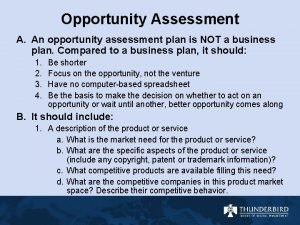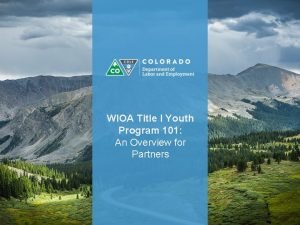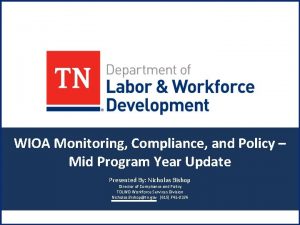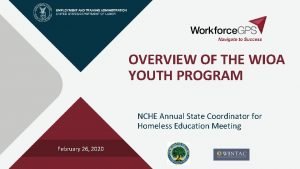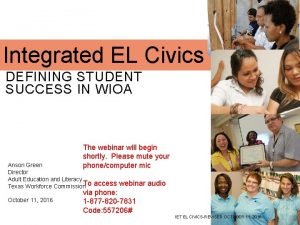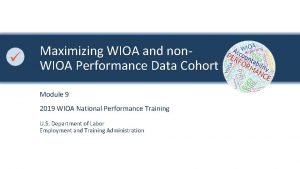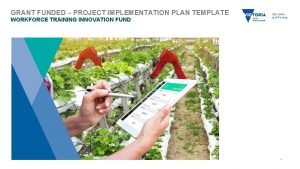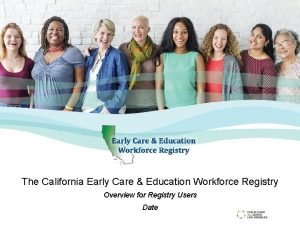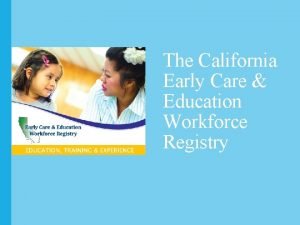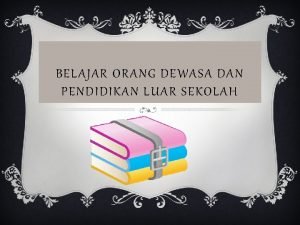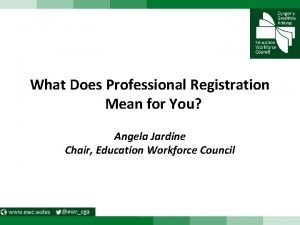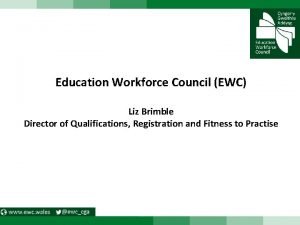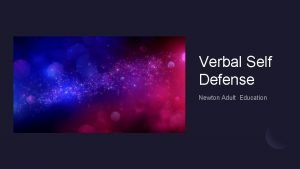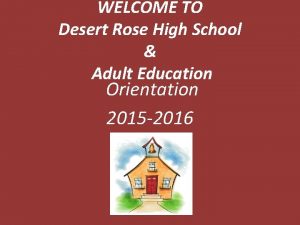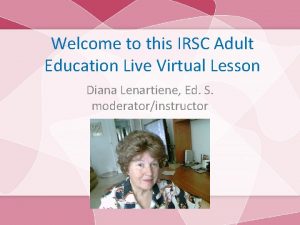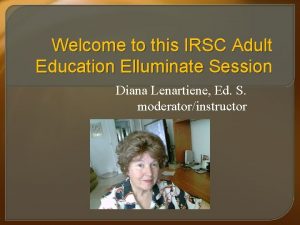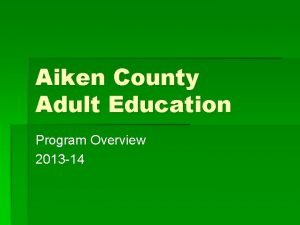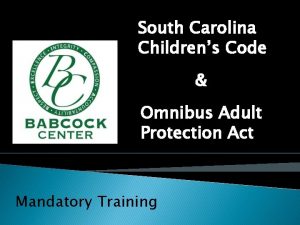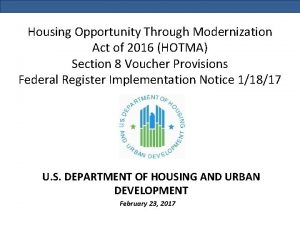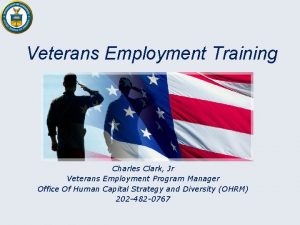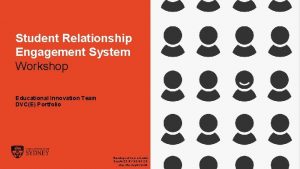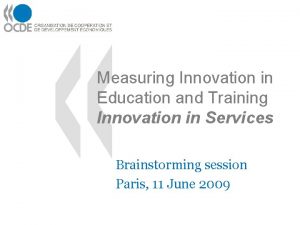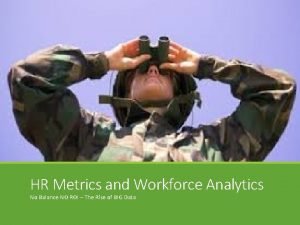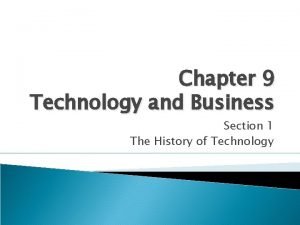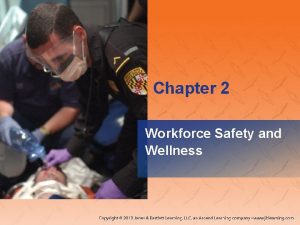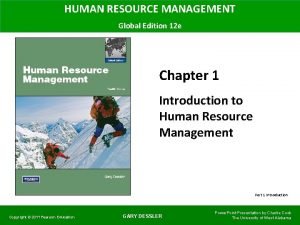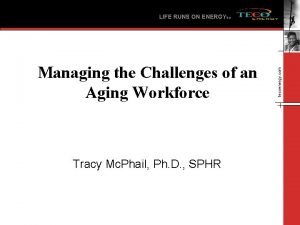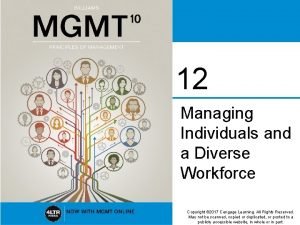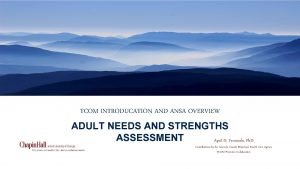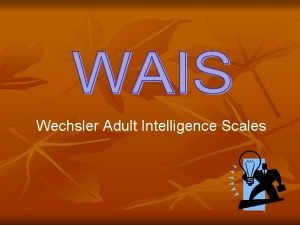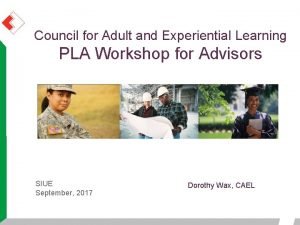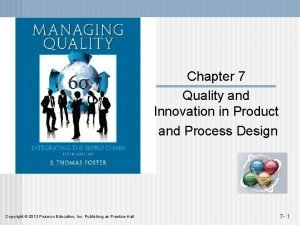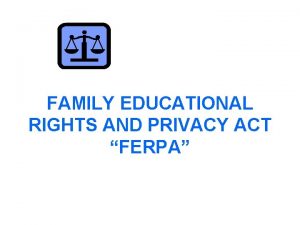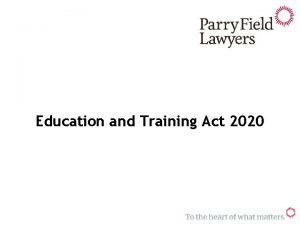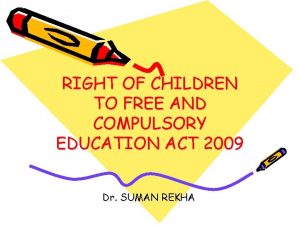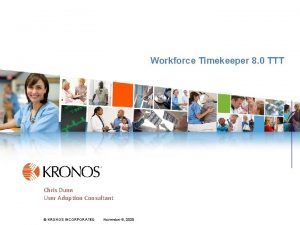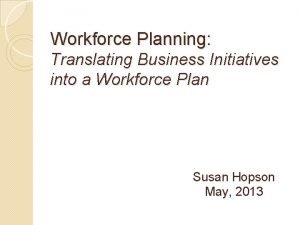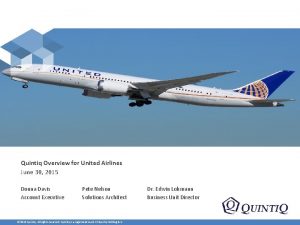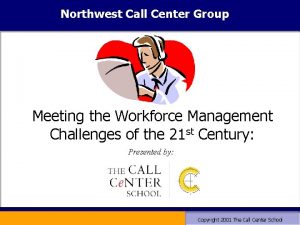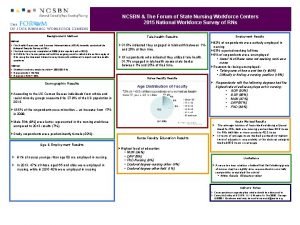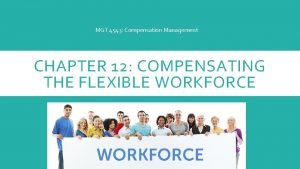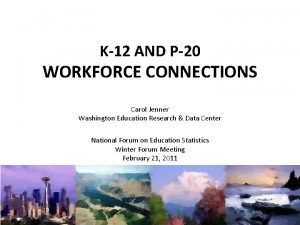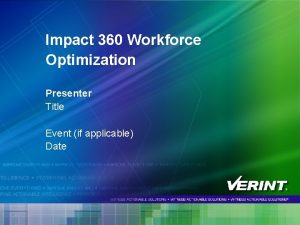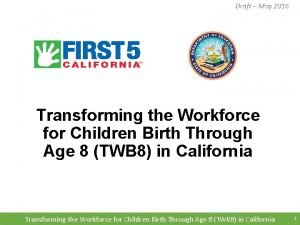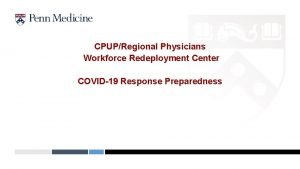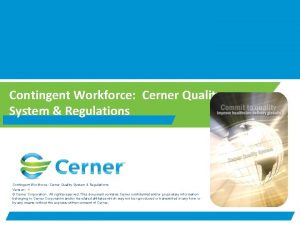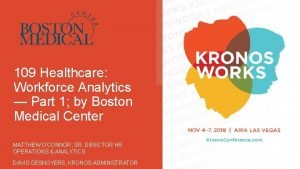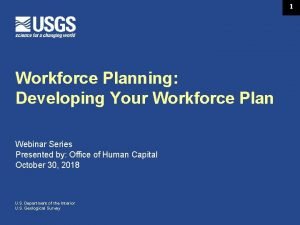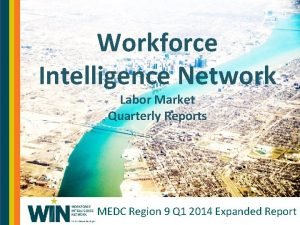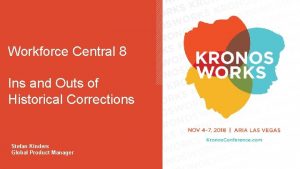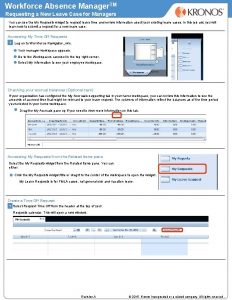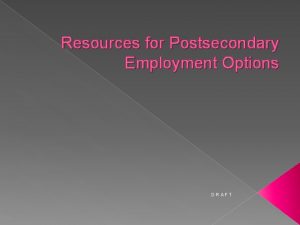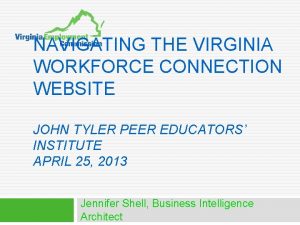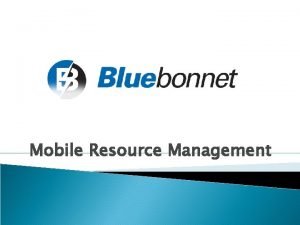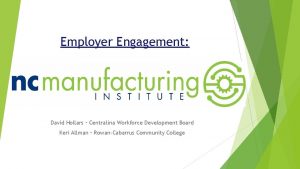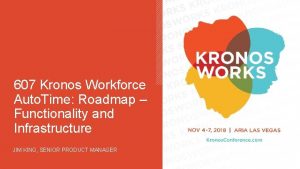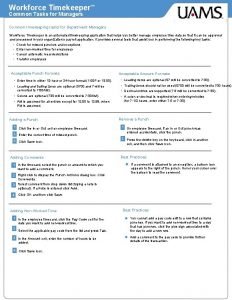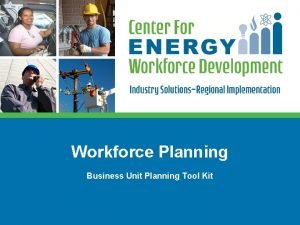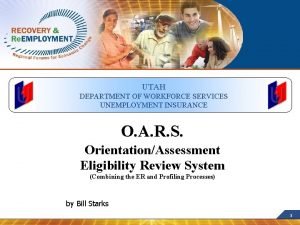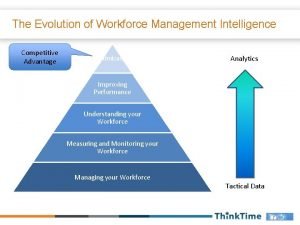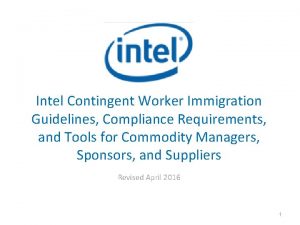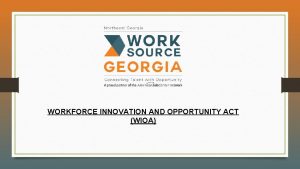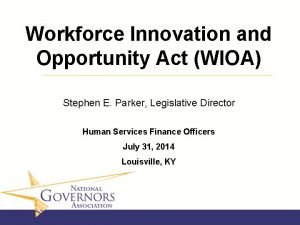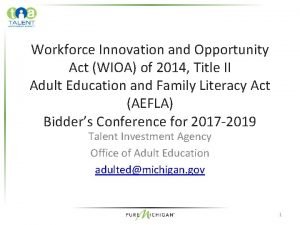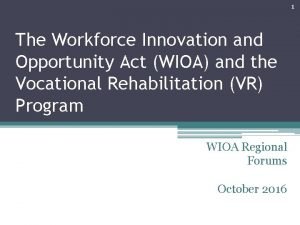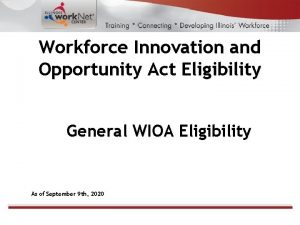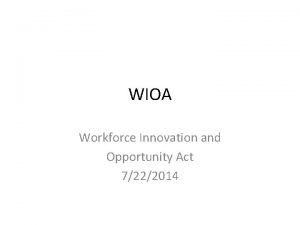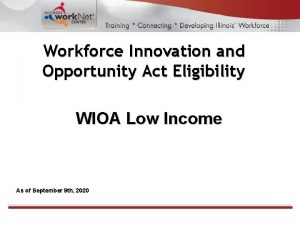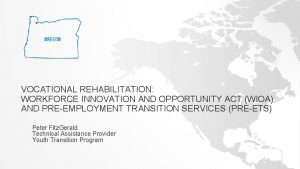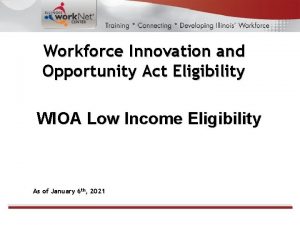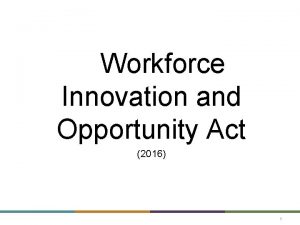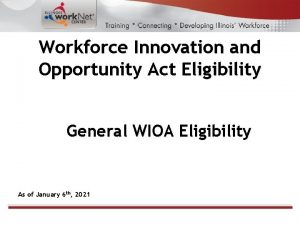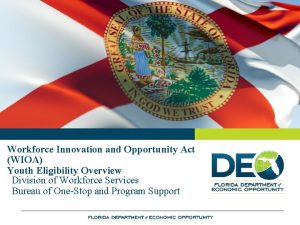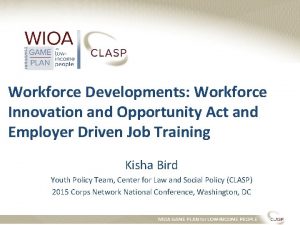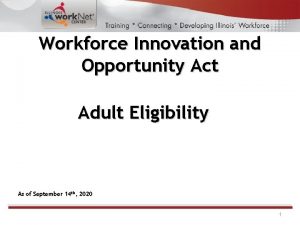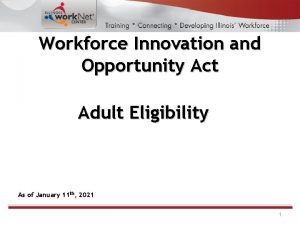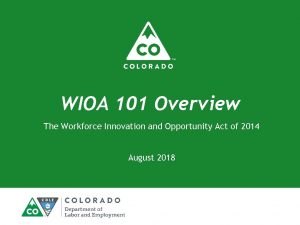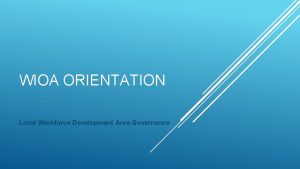Workforce Innovation Opportunity Act WIOA Adult Education and





















































































- Slides: 85

Workforce Innovation & Opportunity Act – WIOA Adult Education and Family Literacy Act – AEFLA Bidder’s Conference February 18, 2020

Welcome • Introductions • Bidder’s Conference • Silence your cellphones • Presentation is being recorded • Available 2/15/20 • Questions & Answers will be available on the website. • All grant information is located on the website at: www. mccb. edu/offices/adult-education/grant-opportunities *check back weekly for updated information

Objectives • Outline the requirements of the grant. • Explain the application components. • Define budget and program requirements. • Provide guidance and answer questions.

Timeline Item Date FY 2021 -2025 Request for Proposal (RFP) Released February 3, 2020 Grant Application Bidders’ Conference February 18, 2020 Deadline to Submit Completed Grant Application March 20, 2020 Package Application Pre-Screen, Evaluation and Negotiation March 23 – April 30, 2020 Processes (including review by Local Workforce Development (LWDB Review: March 23 -31, 2020) Boards) Applicants Notified of Award Decisions May 1, 2020 Finalized Program List Released June 2020 Official Letters Sent to Successful Applicants June 2020 Year One of Grant Contract Begins July 1, 2020

Direct & Equitable Access WIOA, Section 231(C) The competitive grant process ensures: • All eligible providers will have direct and equitable access to apply and compete for grants; • The same grant announcement and application processes are used for all eligible applicants in the State; • All applicants must respond to the same thirteen (13) federal considerations.

Grant Funding Opportunities • Adult Education & Family Literacy Act (AEFLA) • WIOA, Section 231 Funds • Corrections Education & Other Institutionalized Individuals • WIOA, Section 225 Funds • Integrated English Literacy and Civics Education (IELCE) • WIOA, Section 243 Funds


Priorities of Funding As required by WIOA, funding is prioritized for the following applicants: • who have demonstrated effectiveness in improving the literacy of eligible individuals, especially with respect to eligible individuals with low levels of literacy; • whose services are aligned with local workforce strategies, priorities, and partners; and • whose services are responsive to the needs of persons with barriers to employment.

Grant Award Period Fiscal Years 20 -25 Period Initial Period Performance Renewal Period #1 Start Date End Date of July 1, 2020 June 30, 2021 July 1, 2021 June 30, 2022 Renewal Period #2 July 1, 2022 June 30, 2023 Renewal Period #3 July 1, 2023 June 30, 2024 Renewal Period #4 July 1, 2024 June 30, 2025 After the first year, renewals will be contingent on the grant recipient’s ability to successfully implement the terms of the grant and demonstrated effectiveness as determined by outcomes.

Important Information Applicants need to be familiar with the: • Workforce Innovation & Opportunity Act, 2014 • Title II, Adult Education & Family Literacy Act • MS Combined State Plan • Local Workforce Development Plans • Education Department General Administrative Regulations (EDGAR) • Grant Application & Resources • Office of Adult Education Program Guidelines *** RFP Definitions/Acronyms

Office of Adult Education – Program Guidelines • Program Accountability & Performance • Program Design Elements • Assessment Policy • Instructional Standards • Program Administration • Program Personnel Qualifications and Professional Development Requirements

Background and Purpose

Background Workforce Innovation & Opportunity Act, 2014 • Requires the alignment of workforce, education and economic development systems to support access to high-quality, comprehensive, and accessible workforce services for all individuals, including those with significant barriers to employment. • Mississippi Combined State Plan • Smart Start Course • Student Success Plan • Direct referral system with Core Partners

MS Combined State Plan-Required Core Partners • Title I – Adults, Youth and Dislocated Workers • U. S. Department of Labor, MS Department of Employment Security • Title II – Adult Education • U. S. Department of Education, MCCB, Office of Adult Education • Title III – Wagner-Peyser Employment Services • U. S. Department of Labor, MS Department of Employment Security • Title IV – Vocational Rehabilitation Program • U. S. Department of Education, MS Rehabilitation Services • MS included additional MDHS programs

Purpose of Adult Education • Assist adults to become literate and obtain the knowledge and skills necessary for employment and economic self-sufficiency; • Assist adults who are parents or family members to obtain the education and skills necessary to becoming full partners in the educational development of their children and lead to sustainable improvements in the economic opportunities for their family; • Assist adults in attaining a secondary school diploma or its equivalent and in the transition to postsecondary education and training, including career pathways; Page 16 -17 of Grant Application

Purpose of Adult Education • Assist immigrants and other individuals who are English language learners in • Improving their reading, writing, speaking, comprehension skills in English, mathematic skills; and • Acquiring an understanding of the American system of government, individual freedom, and the responsibilities of citizenship; • Provide educational programs for criminal offenders in correctional institutions and for other institutionalized individuals; • Provide Integrated English Literacy and Civics Education program (WIOA Sec. 243(a).

Adult Education means…. • Academic instruction and education services below the postsecondary level that increases an individual’s ability to: • read, write, and speak in English and perform mathematics or other activities necessary for the attainment of a secondary school diploma or its recognized equivalent; • transition to postsecondary education and training; and • obtain employment.

Goals of Adult Education 1. Improve Outcomes by Scaling Effective Models and Strategies across the State. 2. Increase Post-Secondary Transitions and Credential Attainment. 3. Strengthen College and Career Readiness for Adult Learners. 4. Develop Multi-Level Career Pathway Options.

Eligible Services & Allowable Activities Eligible providers must use AEFLA funds to establish or operate programs that provide adult education and literacy activities, including programs that provide these activities concurrently.

Target Population: • Eligible Individuals for service under Title II are individuals who: • have attained 16 years of age; • are not enrolled or required to be enrolled in secondary school under state law (MS Code 37 -13 -91); • lack sufficient mastery of basic educational skills to enable the individuals to function in society; • do not have a secondary school diploma or its recognized equivalent; and • are English language learners (ELL).

Adult Education & Family Literacy Act Allowable Activities: Section 231 and Section 225 • Adult Basic Education (ABE) • Adult Secondary Education (ASE) • English Language Acquisition (ELA) • Integrated Education and Training (IET) • Integrated English Literacy and Civics Education (IELCE) • If applicable • Workforce Preparation Activities: Activities in BOLD are required for 231 and • Smart Start Course - Required 225 Page 18 of Grant Application

Adult Basic Education (ABE) • A program of academic instruction and education services below the secondary level that increases an individual’s ability to read, write, and speak in English and perform mathematics necessary to attain a secondary school diploma or its recognized equivalent, transition to postsecondary education or training, and obtain employment. • Refers to instruction at the 0 -8. 9 grade levels. • National Reporting System (NRS) Educational Functioning Levels (EFL) 1, 2, 3 or 4.

Adult Secondary Education (ASE) • A program of academic instruction and education services at the secondary level that increases an individual’s ability to read, write, and perform mathematics necessary to attain a secondary school diploma, or its recognized equivalent, transition to postsecondary education or training, and obtain employment. • Refers to instruction at the 9. 0 – 12. 9 grade levels. • National Reporting System (NRS) Educational Functioning Levels (EFL) 5 or 6.

English Language Acquisition (ELA) Program • A program of instruction designed to help eligible individuals who are English language learners (ELLs): • achieve competence in reading, writing, speaking, and comprehension of the English language; • attain a secondary school diploma or its recognized equivalent; and • transition to postsecondary education, training or employment. • Adult education programs offering English language acquisition services are required to include civics education. • National Reporting System (NRS) Educational Functioning Levels (EFL) for ESL 1 -6.

Workforce Preparation Activities • All funded applicants are required to provide the Smart Start Course. (State Requirement) • The Smart Start Course meets the requirements of Workforce Preparation Activities defined as: • Activities, programs, or services designed to help an individual acquire a combination of basic academic skills, critical thinking skills, digital literacy skills, and self-management skills, including competencies in utilizing resources, using information, working with others, understanding systems, and obtaining skills necessary for successful transition into and completion of postsecondary education or training, or employment (Section 203 (17) of WIOA).

26

IET is…Integrated Education and Training • A service approach that provides adult education and literacy activities concurrently and contextually with workforce preparation activities and workforce training for a specific occupation or occupational cluster for the purpose of educational and career advancement. • Definition from WIOA Section 203 (11) Mississippi Integrated Basic Education and Training program:


Integrated English Literacy & Civics Education (IELCE): Allowable Activities: Section 243 • Educational services provided to adult English language learners, who are adults, including professionals with degrees and credentials in their native countries, that enable such adults to achieve competency in the English language and acquire the basic and advanced skills needed to function effectively as parents, workers, and citizens in the United States. • Such services include instruction in literacy and English language acquisition and instruction on the rights and responsibilities of citizenship and civic participation, and may include workforce training (Section 203 (12) of WIOA). Applicants MAY apply for Section 243 funds ONLY

Adult Education & Family Literacy Act Allowable Activities: Section 231 and Section 225 • Adult Basic Education (ABE) • Adult Secondary Education (ASE) • English Language Acquisition (ELA) • Integrated Education and Training (IET) • Integrated English Literacy and Civics Education (IELCE) • If applicable • Workforce Preparation Activities: • Smart Start Course - Required Page 18 of Grant Application

Determining Applicant Eligibility Who can apply?

Eligible Applicants • An organization must be considered an eligible provider to receive federal adult education funding. • An “eligible provider” is defined as an organization that has demonstrated effectiveness in providing adult education and literacy activities. • States must clearly determine whether or not an application is from an eligible provider of demonstrated effectiveness.

Eligible Applicants An organization must be considered an eligible provider to receive federal adult basic education funding. An “eligible provider” is defined as an organization that has demonstrated effectiveness in providing adult education and literacy activities. These organizations may include, but are not limited to (WIOA Title II Section 203(5); 34 CFR 463. 23) a (an): • local educational agency; • community-based organization or faith-based organization; • volunteer literacy organization; • institution of higher education; • public or private nonprofit agency; • library; • public housing authority; • nonprofit institution not described in (a) through (g) of this section and has the ability to provide adult education and literacy activities to eligible individuals; • consortium or coalition of the agencies, organizations, institutions, libraries, or authorities described in (a) through (h) of this section; and

Demonstrated Effectiveness • An eligible provider must demonstrate past effectiveness by providing performance data on its record in improving the skills of eligible individuals, in particular, individuals who are basic skills deficient in the content domains of reading, writing, mathematics, and English language acquisition. • An eligible provider must also provide information regarding its outcomes for participants related to employment, attainment of secondary school diploma or its recognized equivalent, and transition to postsecondary education and training, per federal regulations 34 CFR 463. 24.

Past Effectiveness can be Demonstrate Two Ways: • An eligible provider that has been previously funded under Title II of the Act must provide two (2) consecutive years (State Requirement) of performance data in Table 2. 1 and Table 2. 2 to demonstrate past effectiveness in the areas listed above. (Section III, Application). • An eligible provider that has not been previously funded under Title II of the Act must provide two (2) consecutive years (State Requirement) of performance data in Table 2. 3 and Table 2. 4 to demonstrate its past effectiveness in serving basic skills deficient eligible individuals, including evidence of its success in achieving outcomes listed in the WIOA Title II AEFLA Federal Requirements. (See federal regulations 463. 24). (Section III, Application). Consortium Applicants Each consortium member must meet the eligibility criteria as outlined above. Consortium members must complete either: Table 2. 1 and 2. 2 OR Table 2. 3 and 2. 4, individually (Section III, Application).



Once a State has completed its process to evaluate each application’s data on demonstrated effectiveness, it may advance only those applications that passed the eligibility screening for review and consideration of funding. Applications that did not result in a determination that the application was from an organization of demonstrated effectiveness cannot be further considered for funding.

Program Requirements

Personnel and Staffing • Programs are required to maintain certain program staffing to ensure the quality of grant administration; supervision; data collection, entry, and reporting; student support; and instruction. • All staff must be properly qualified to fulfill the duties listed in their written job description through training, education, or experience and must complete required training and professional-development activities.

Personnel and Staffing To ensure quality of programs and performance requirements, the OAE recommends the following minimum staff to support the adult education program: • Adult Education Director/Administrator • Full-time with at least 75% of time dedicated to AE • Prefer Master’s Degree/Bachelor’s required • Transition Specialist/Navigator • All programs must have at least ONE dedicated staff member to provide these services. • Bachelor’s Degree required • Directly related to our program outcomes; • Must have sufficient time in advising, planning, delivering individualized services, and coordinating resources that will assist students’ progression toward transitioning into postsecondary education/training or the workforce.

Personnel and Staffing • Mentor/Lead Instructor • AE experience and must be approved by the OAE. • Bachelor’s Degree required • Instructors: Full-time and/or part-time • Bachelor’s Degree required • 10: 1 student teacher ratio minimum per class • Academic Assistant • Based on student enrollment/need • Data Specialist/Intake Specialist

Standards and Instruction • The OAE is committed to providing standards-based instruction through evidence-based researched strategies. The College and Career Readiness Standards (CCRS) should be the basis of lesson planning, classroom activities, assignments, and classroom assessments. • Adult education instructors must have a thoughtful plan, with clearly articulated methods, as to how they will sequence lessons, use instructional materials, and design learning activities. Lesson plans and instructional strategies should make career awareness and workforce skills a central context for learning.

Approved Assessments The OAE has adopted the following assessment instruments from the NRS list of approved assessments. Only scores from these assessment instruments will be accepted for data entry and NRS reporting. Assessment Instruments Adult Education Program Areas TABE CLAS-E English as a Second Language (ESL) Integrated English Literacy and Civics Education (IELCE) TABE 11 & 12 Adult Basic Education (ABE) Adult Secondary Education (ASE)

Professional Development Annual Professional Development Requirements Directors Attendance required at all OAE Director meetings/workshops/PD New Directors Must attend New Directors Training within 12 months of hire Support Staff 15 hours Academic Assistants 15 hours New Instructors Must attend the New Teacher’s Academy within 12 months of hire AND complete required hours of PD Full-Time Instructors/Transition Specialist Mentor/Lead 30 hours Instructors 30 hours Transition Specialist 20 hours ESL Instructors 30 hours Part-Time Instructors/Transition Specialist Instructors (AE/ESL) 20 hours

Professional Development Requirements • Develop an annual Professional Development Plan which identifies local/state professional development events that will support key program goals; • Provide local professional development to ALL faculty (part-time and full-time) and program staff (leadership, administrative, data management, transition specialist, etc. ); • Participate in OAE professional development offerings as appropriate and/or deemed mandatory by the agency; and • Track and document all professional development activities including: • • Sign-In Sheets; Agenda; Handouts; and Power. Point Presentation.

Local Workforce Development Boards Alignment • WIOA requires each eligible, seeking applicant to describe how services proposed in the application will align with applicable local workforce development plan(s), including the items shown below: . • The degree to which the Title II application responds to regional needs as identified in the Local Workforce Plan; • The degree to which the Title II application responds to serving individuals in the community identified as most in need of adult education and literacy activities, including individuals who have low levels of literacy skills or are English language learners; • The extent to which the Title II applicant’s proposed activities and services demonstrate alignment to the strategies and goals of the Local Workforce Plan; • The extent to which the Title II applicant’s proposed activities and services demonstrate alignment to the activities and services of the one-stop partners, including providing access to adult education services through the one-stop system.

One-Stop Partner Requirements • Adult education is a required one-stop partner and will be co-located in Comprehensive One-Stop Centers that provide access to the services of the Combined Plan programs and other partners in each of the four local workforce development areas. • These agreements may include a comprehensive referral system and shared customer-base, shared system costs and co-location when appropriate, and other shared services to ensure access to information and services that will lead to positive employment outcomes is available to all participants.

Financial Requirements • All grantees must meet the requirements of the Education Department General Administrative Regulations (EDGAR): • Federal regulations that govern all federal grants awarded by the U. S. Department of Education. www. ed. gov/policy/fund/reg/edgar. Reg/edgar. html • All grantees will be reimbursed for expenditures, as approved, by requesting reimbursement through the MCCB web-based financial budgeting system. • Requests for reimbursement must be submitted monthly and all documentation must be available upon request. • Grantees shall ensure auditable and adequate records are maintained which support the expenditure of all funds received through a contract with the MCCB, OAE. • Grantees will submit to periodic fiscal audits, adhere to assurances and will submit to periodic program review, monitoring, and/or technical assistance on-site visits.

Uniform Guidance 2 CFR Part 200 • Allowable: refers to items of cost, that in general, are costs that can be funded with federal grant dollars as long as the cost fits within a framework of responsible stewardship of public funds. • Allocable: the cost of the item is proportional to the benefit the program will receive from the cost (especially important when it comes to salaries) • Reasonable: A cost is “reasonable” if, in its nature and amount, it does not exceed that which would be incurred by a prudent person • Necessary: A cost is “necessary” if it meets an important program objective - it must address an existing need.

Supplement not Supplant • Title II must supplement, and not supplant other state or local public funds expended for adult education and literacy activities. • Supplement, not supplant means the federal funds are intended to augment or increase, not replace, monies that would have been used if the federal funds had not been available.

Match Requirement • Applicants must demonstrate a match of 25% of the funds requested. Federal funds may not be used for matching funds. • May include both in-kind and cash matches. • State dollars, local-dollars, private dollars, or in-kind support.

Time & Effort Reporting • Uniform Guidance (2 CFR Sec. 200. 430) requires time distribution records must be maintained for all employees whose salary is paid in whole or in part with federal funds or is used to meet a match or cost share requirement for a grant. • Time and effort reporting is a federal compliance requirement and is almost always requested and reviewed by federal auditors when grants are under review.

Allowable Expenditures • Administration Costs: 5% limit • Includes administrator salary and benefits, operational costs, indirect costs, and the infrastructure funding agreement costs. • Special Rule • Salary and Benefits • Instructional Material • Assessments • Professional Development Activities

Budget Guidelines - Salaries Position Director Hourly Rate Range Administration costs are limited to 5% of total grant Transition Specialist $ 18. 00 – $ 22. 00 Lead Instructor/Mentor $ 23. 00 Must have Adult Education Teaching experience Instructors $ 18. 00 – $ 22. 00 Academic Assistant $ 11. 00 - $ 15. 00 (Aide) Data /Intake Specialist $ 11. 00 - $ 15. 00

Unallowable Activities • Capital improvements which add permanent value; • General purpose equipment; (e. g. furniture, microwaves, air conditioning, appliances) • Food-related expenses; • Scholarships and student aid costs; • Lobbying; • Gifts for instructors or students; • Entertainment; • Graduation expenses; • Travel for anything other than approved adult education business; • Expenses for anyone other than adult education staff. • HSE and workforce credential testing costs, including proctoring, are unallowable

Equipment • Grant recipients must have written policies and procedures for purchasing and expenditures to support allowable activities. • All equipment purchases must be consistent with the requests in the approved budget. Inventory is subject to periodic program review and monitoring.

Facilities • The eligible provider shall provide suitable American Disabilities Act compliant space conducive to adult learning for the local literacy program. • The facility shall include office space(s), adequate classrooms for instruction and separate space for orientation and testing. • The learning environment must be in good condition and properly maintained.

Monitoring & Technical Fiscal and compliance monitoring is conducted throughout the year to Assistance determine compliance with federal and State Requirements. • Desk Top Monitoring/Data Reviews • One hundred percent (100%) of AEFLA funded programs will be monitored annually • Monitoring Visits/On-Site Program Reviews • Bi-annual Performance Report Card

Accountability and Performance Outcomes • Employment Rate – 2 nd Quarter After Exit: The percentage of participants who are in unsubsidized employment during the second quarter after exit from the program. • Employment Rate – 4 th Quarter After Exit: The percentage of participants who are in unsubsidized employment during the fourth quarter after exit from the program • Median Earnings – 2 nd Quarter After Exit: The median earnings of participants who are in unsubsidized employment during the second quarter after exit from the program.

Accountability and Performance • Credential Attainment: The percentage of those participants enrolled in an education or training program who attain a recognized postsecondary credential or a secondary school diploma, or its recognized equivalent, during participation in or within one year after exit from the program.

Accountability and • Performance Measurable Skill Gains: • Documented achievement of at least one educational functioning level of a participant who is receiving instruction below the postsecondary education level; • Documented attainment of a secondary school diploma or its recognized equivalent.


Application Preparation

• Checklist • Applications must be complete in order to be considered for funding. • Incomplete application packages will not be considered. • Proposal Format • Applications must be submitted in the format and content specified in these instructions. • 12 -point font, single-spaced, 1 -inch margins and numbered pages. • The signature page must include original signatures of the Authorized Representative, Program Administrator and Fiscal Manager in BLUE INK. • No hand written applications will be accepted. • Each narrative response should be limited to 5, 000 characters (approximately 500 to 1000 words). • PDF format.

Submission Deadline March 20, 2020, 4: 00 p. m. , local time. Applicants must submit three (3) complete copies of the RFP package. One (1) electronic copy emailed in PDF format to adulteducation@mccb. edu Two (2) paper copies bearing original signatures in BLUE INK Mail Paper Copies to: Mississippi Community College Board Office of Adult Education Attn: Sandy Crist 3825 Ridgewood Road Jackson, MS 39211

Budget Submission

Budget Narrative • Applicants must prepare and submit a proposed budget for the provision of educational services in FY 2021 (July 1, 2020 – June 30, 2021) under this grant proposal as a required component. • Describe how funds will be spent consistent with Title II requirements. Include the activity(ies) that will be provided and how funds will be allocated. • Applicants should also provide a detailed narrative describing the costs of administration, instruction (instructors, paraprofessionals, textbooks and software), maintenance and operation (rent, utilities custodial services, etc. …), and other support services (equipment, conference travel, etc. ) as well as a line item budget for each grant.

Budget Narrative • Explain how the costs of the proposed project (as presented in the attached budget and budget narrative) are reasonable and sufficient to implement the proposed activities. • Applicants should complete and submit the Adult Education Budget Worksheet. This worksheet can be found at: https: //www. mccb. edu/offices/adult-education/grantopportunities • Proposed budgets will be reviewed by the OAE and are subject to negotiation between OAE and the applicant.

Budget Worksheet

Budget Worksheet

Evaluation Process

Pre-Screening Process • All Grant Applications submitted by March 20, 2020 will be pre-screened prior to review to verify that the following criteria have been met: • Complete application is submitted by the required due date, • Determination of eligible applicant • Demonstrated effectiveness in providing services to improve the literacy of eligible individuals, especially those individuals with low literacy skills, is provided.

Once a State has completed its process to evaluate each application’s data on demonstrated effectiveness, it may advance only those applications that passed the eligibility screening for review and consideration of funding. Applications that did not result in a determination that the application was from an organization of demonstrated effectiveness cannot be further considered for funding.

Review Process – 3 part 1. process Applications will be reviewed by applicable Local Workforce Development Board(s) regarding the proposal’s alignment with the local workforce development plan and the Boards will provide recommendations to the OAE to promote such alignment. 2. A review panel comprised of individuals with expertise in adult education and literacy will evaluate proposals, using a rubric-based evaluation tool. The panel will provide recommendations to the OAE regarding consideration for funding. 3. Pre-Award Risk Assessment Tool– (document available in the Resource Section on grant website)

Criteria Used to Evaluate Applications • 13 Federal Considerations • Evaluation Criteria (see page 52 of grant application) Page 52 of grant application

Federal Considerations 1. The degree to which the eligible provider would be responsive to: a) Regional needs as identified in the local workforce development plan; and b) Serving individuals in the community who were identified in such plan as most in need of adult education and literacy activities, including individuals: i. Who have low levels of literacy skills; or ii. Who are English language learners; 2. The ability of the eligible provider to serve eligible individuals with disabilities, including eligible individuals with learning disabilities; 3. The past effectiveness of the eligible provider in improving the literacy of eligible individuals, especially those individuals who have low levels of literacy, and the degree to which those improvements contribute to meeting the state–adjusted levels of performance for the primary indicators of performance described in section 116;

Federal Considerations 4. The extent to which the eligible provider demonstrates alignment between proposed activities and services and the strategy and goals of the local plan under section 108 of the Act, as well as the activities and services of the American Job Centers (WIN) One-Stop partners; 5. Whether the eligible provider’s program: a. Is of sufficient intensity and quality, and based on the most rigorous research available so that participants achieve substantial learning gains; and b. Uses instructional practices that include the essential components of reading instruction; 6. Whether the eligible provider’s activities, including whether reading, writing, speaking, mathematics, and English language acquisition instruction delivered by the eligible provider, are based on the best practices derived from the most rigorous research available, including scientifically valid research and effective educational practice;

Federal Considerations 7. Whether the eligible provider’s activities effectively use technology, services and delivery systems, including distance education, in a manner sufficient to increase the amount and quality of learning and how such technology, services, and systems lead to improved performance; 8. Whether the eligible provider’s activities provide learning in context, including through integrated education and training, so that an individual acquires the skills needed to transition to and complete postsecondary education and training programs, obtain and advance in employment leading to economic selfsufficiency, and to exercise the rights and responsibilities of citizenship; 9. Whether the eligible provider’s activities are delivered by instructors, counselors, and administrators who meet any minimum qualifications established by the State, where applicable, and who have access to high-quality professional development, including through electronic means;

Federal Considerations 10. Whether the eligible provider’s activities coordinate with other available education, training, and social service resources in the community, such as establishing strong links with elementary schools and secondary schools, postsecondary educational institutions, institutions of higher education, LWDBs, WIN Job Centers, job training programs, social service agencies, business, industry, labor organizations, community-based organizations, nonprofit organizations, and intermediaries, in the development of career pathways; 11. Whether the eligible provider’s activities offer flexible schedules and coordination with federal, state, and local support services (such as child care, transportation, mental health services, and career planning) that are necessary to enable individuals, including individuals with disabilities or other special needs, to attend and complete programs;

Federal Considerations 12. Whether the eligible provider maintains a high-quality information management system that has the capacity to report measurable participant outcomes (consistent with section 116) and to monitor program performance; and 13. Whether the local area in which the eligible provider is located has a demonstrated need for additional English language acquisition programs and civics education programs.

Pre-Award Risk Assessment Tool • A risk assessment tool is used to select providers annually for a comprehensive compliance review, using an intensive process that includes onsite monitoring, observation of program operations, interviewing of staff and physical auditing of records. • Assessment Tool is available on the website at: https: //www. mccb. edu/offices/adult-education/grantopportunities

Priorities of Funding As required by WIOA, funding is prioritized for the following applicants: • who have demonstrated effectiveness in improving the literacy of eligible individuals, especially; with respect to eligible individuals, who have low levels of literacy; • whose services are aligned with local workforce strategies, priorities, and partners; and • whose services are responsive to the needs of persons with barriers to employment.

Grant Assurances • Important • Signatures required from Program Director, Fiscal Agent and President/Superintendent/CEO

 Opportunity assessment plan sample
Opportunity assessment plan sample Wioa youth program elements
Wioa youth program elements Wioa
Wioa Wioa
Wioa Wioa
Wioa Wioa optimized system
Wioa optimized system Wioa maryland
Wioa maryland Grant implementation plan example
Grant implementation plan example Workforce innovation fund
Workforce innovation fund Innovation for the sake of innovation
Innovation for the sake of innovation Disruptive and radical innovation
Disruptive and radical innovation Early care and education workforce registry
Early care and education workforce registry Workforce registry ca
Workforce registry ca Life long education artinya
Life long education artinya Education workforce council
Education workforce council Education workforce council
Education workforce council Fremont adult education
Fremont adult education Newton adult education
Newton adult education Desert rose adult education
Desert rose adult education Irsc adult education
Irsc adult education Irsc adult education
Irsc adult education Aiken county adult education
Aiken county adult education Omnibus adult protection act
Omnibus adult protection act Macbeth act 2 summary
Macbeth act 2 summary Housing opportunity through modernization act
Housing opportunity through modernization act 5 cfr 213,3102(u)
5 cfr 213,3102(u) Innovation workshop sydney
Innovation workshop sydney Measuring innovation in education
Measuring innovation in education Hr metrics and workforce analytics
Hr metrics and workforce analytics Chapter 9 technology and business
Chapter 9 technology and business Workforce safety and wellness chapter 2
Workforce safety and wellness chapter 2 Globalization and competition trends in hrm
Globalization and competition trends in hrm Managing the aging workforce challenges and solutions
Managing the aging workforce challenges and solutions Surface-level diversity
Surface-level diversity What are the challenges brought by media and information
What are the challenges brought by media and information Adult needs and strengths assessment
Adult needs and strengths assessment Skala wechsler
Skala wechsler A day with nandu lesson plan
A day with nandu lesson plan Council for adult and experiential learning
Council for adult and experiential learning Guidelines for adult stroke rehabilitation and recovery
Guidelines for adult stroke rehabilitation and recovery Quality and innovation in product and process design
Quality and innovation in product and process design How formal education differ from als
How formal education differ from als Difference between health promotion and health education
Difference between health promotion and health education Family educational rights and privacy act
Family educational rights and privacy act Education and training act 2020 summary
Education and training act 2020 summary Punjab free and compulsory education act 2014
Punjab free and compulsory education act 2014 Antecedent passions do not always destroy freedom.
Antecedent passions do not always destroy freedom. Ra. 9344
Ra. 9344 Workforce timekeeper
Workforce timekeeper Workforce analysis
Workforce analysis Significance of human resource planning
Significance of human resource planning Workforce planning nedbank
Workforce planning nedbank Quintiq rostering
Quintiq rostering Workforce transformation opwdd
Workforce transformation opwdd Call center school workforce management
Call center school workforce management National forum of state nursing workforce centers
National forum of state nursing workforce centers Compensating the flexible workforce
Compensating the flexible workforce P20 workforce
P20 workforce Impact 360 workforce management
Impact 360 workforce management Transforming the workforce
Transforming the workforce Workforce redeployment
Workforce redeployment Workforce.cerner.com
Workforce.cerner.com Offender workforce development specialist
Offender workforce development specialist Digital ready workforce
Digital ready workforce Avaya wfo
Avaya wfo Scenario planning workforce planning
Scenario planning workforce planning Kronos workforce analytics for healthcare
Kronos workforce analytics for healthcare Workforce analysis
Workforce analysis Oakland community college
Oakland community college Kronos workforce central 8
Kronos workforce central 8 Workforce absence manager
Workforce absence manager Workforce flow
Workforce flow School workforce census 2017
School workforce census 2017 Lousiana workforce commission
Lousiana workforce commission Www.vaworkconnect.com
Www.vaworkconnect.com Mobile resource management solutions
Mobile resource management solutions Golden sierra workforce development board
Golden sierra workforce development board Centralina workforce development board
Centralina workforce development board Solumina tutorial
Solumina tutorial Workforce timekeeper
Workforce timekeeper Strategic workforce planning toolkit
Strategic workforce planning toolkit Utah unemployment eligibility review
Utah unemployment eligibility review Evolution of workforce management
Evolution of workforce management Strategic workforce
Strategic workforce Contingent worker letter
Contingent worker letter Talent analyst emsi
Talent analyst emsi
